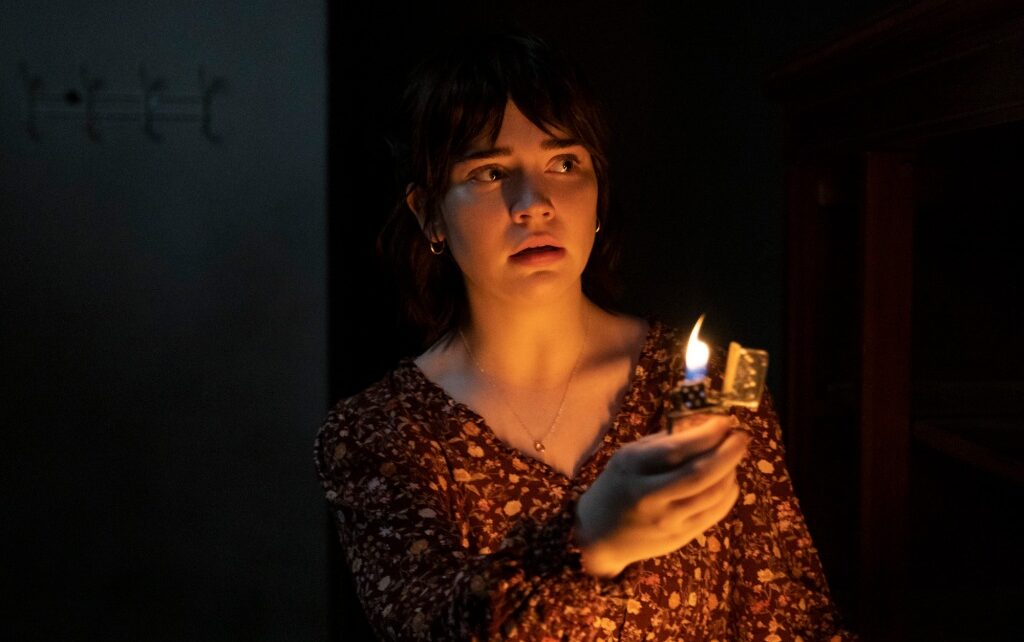There are few fears more universal than one of a monster under the bed or in our closet, and few filmmaking techniques more viscerally effective than the jump scare. These tropes collide — effectively, if without much originality — in “The Boogeyman,” a loose adaptation of Stephen King’s 1973 short story of the same name. Featuring an eponymous threat seemingly drafted from the same biological blueprint as the extraterrestrials in their breakthrough film “A Quiet Place,” writers Scott Beck and Bryan Woods graft the psychological and thematic shorthand of unresolved trauma onto a creature feature, while director Rob Savage (“Dashcam”) papers over the seams between the two with copious style and a bold, clear-eyed lead performance coaxed from “Yellowjackets” star Sophie Thatcher.
Thatcher plays Sadie Harper, a withdrawn high school student wrestling with the recent death of her mother in a car accident. Though Sadie’s father Will (Chris Messina) works as a therapist, he’s too consumed by his own grief to provide comfort for her or her little sister Sawyer (Vivien Lyra Blair), who’s terrified of the dark. When a man named Lester Billings (David Dastmalchian) shows up unexpectedly at their home telling stories about the cryptic deaths of his three children, Will appropriately calls the authorities. Before they can arrive, Lester disappears into a closet and seemingly commits suicide.
Sadie is present when Will discovers the body, but even then he refers his daughter to Dr. Weller (LisaGay Hamilton), a grief counselor, rather than discussing her feelings directly. In the meantime, Sawyer has become convinced that a creature lurks in the dark corners of her room and is waiting to prey upon her after the lights go out. As Sadie attempts to navigate a way through this compounding series of tragedies, she becomes obsessed with the details of Lester Billings’ life — and especially the images of an otherworldly entity that she uncovers in a notebook he left in her father’s office. She soon becomes convinced that the entity is real, and must find a way to defeat it before it claims her and the rest of her family as its next victims.
Loss is a powerfully relatable catalyst for emotion, so it makes sense that filmmakers would draw from that well to create a heightened atmosphere for their stories. But in recent horror cinema, dead parents have become more of a plot-driving cornerstone than during Disney’s hand-drawn animated heyday. Not only has this trend cheapened the setup, it’s invited a challenge not frequently enough met by writers or directors to meld that weight with physical or psychological thrills that cathartically pay it off. And so you get a movie like “The Boogeyman,” which starts as the study of a family working through its members’ grief and pain, and concludes as a literal battle to kill the monster threatening their lives.
Suffice it to say there’s nothing wrong with that shift — and one can almost guarantee hordes of teenagers will be excited to watch it unfold on screen. But in a genre that increasingly demands to be taken seriously, simple proficiency of technique won’t take a film to the top ranks of the canon. As writers, Beck and Woods have demonstrated they know how to tap into broadly shared, identifiable feelings of vulnerability and longing; Savage keeps his audience poised on the edges of their seats, squinting at every shadow until a monster comes shrieking out of it. Together, they frighten and unsettle, discomfit and shock, but the residue of their efforts is ephemeral at best.
That they lean so heavily on the twin mechanics of world-building and mood-setting further undercuts the lasting impact of what could have been a scarefest with staying power. Back in 1978 when John Carpenter offered his take on “the Boogeyman” in “Halloween,” he understood how frightening it was to watch a sociopathic murder cut a path through clean, bright suburban normalcy. By comparison, Savage wrings creepiness from morning sunlight and refuses interior illumination unless it somehow casts a menacing glow over the characters. Beck and Woods, meanwhile, devote so much screen time to Sophie’s search for one helpful, expository monologue after another about the Boogeyman’s origins that they seem to forget the members of the Harper family who aren’t on screen, despite the fact they spend most of their time in the same home — and should be able to hear one another, or even just be nearby when loud, violent, scream-inducing incidents occur.
Savage’s confidence behind the camera sustains the film’s intensity even when the connective tissue between plot and theme, logic and tone is tenuous at best. But even working alongside sturdy collaborators like Messina and young Blair, it’s Thatcher who sells the improbable reality of an old-as-time spirit preying upon the frightened and grieving. Playing the family member most determined to chart the emotional fallout of her mother’s death before it descends upon the Harpers, the young actor nimbly dances on an edge between desperation and fearlessness, suggesting Sadie believes she could move on if only she could decode the mythology of the monster.
Whether or not it leads to the sequel hinted at in its final scenes, Savage’s King adaptation qualifies as one of the best films in history bearing that title so far, delivering scares that surpass its PG-13 rating even if they’re not especially inventive. Then again, it bears the namesake of one of the oldest and most recognizable myths of the last two centuries, so why not play the hits, cinematically speaking, when rekindling it for contemporary audiences? Good but not great, “The Boogeyman” vividly reminds viewers what it’s like to be afraid of the dark — but for better or worse, the effect doesn’t linger once the lights come back on.
Read More About:
Source: Read Full Article

